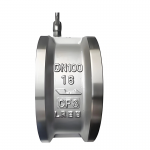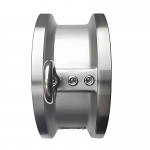Specification
TIANYU Wafer-Type Metal-Seated Check Valve: Precision Backflow Prevention for Industrial Pipelines
I. Product Overview
II. Core Technical Parameters
-
Specifications & Pressure-Temperature Range
- Nominal Diameter: DN50/80/100/150/200/250/300 (2″-12″)
- Pressure Class: PN16 (shell test pressure 2.4MPa, sealing test pressure 1.76MPa)
- Temperature Range: -196℃~230℃ (304 SS), -101℃~600℃ (316 SS)
-
Materials & Sealing System
- Body/Disc: 304 stainless steel (ASTM A351 CF8), 316 stainless steel (ASTM A351 CF8M)
- Sealing Pair: Metal-to-metal seal (surface roughness Ra≤0.8μm), leakage rate ≤1×10⁻⁶cc/s (API 598)
- Connection: Wafer type (fits ANSI B16.5/GB/T 9113 flanges)
- Pin Shaft: 2Cr13 stainless steel (HRC35+), erosion-resistant
-
Mechanical Performance
- Opening Pressure: ≤0.02MPa (forward flow resistance)
- Closure Response Time: ≤0.3s (triggered by backflow)
- Fatigue Life: 100,000 cycles without seal failure (GB/T 13932)
Product Overview
III. Structural Design & Technical Features
-
Butterfly Check Mechanism
- Disc rotates around a horizontal pin with streamlined flow path, pressure drop 30% lower than lift checks (DN100 loss ≤0.08MPa).
- Single/double-disc design: Double discs for large sizes disperse medium impact, preventing water hammer.
-
Metal Seal Optimization
- Disc-seat conical fit (3°-5° angle) self-tightens via medium pressure, specific pressure ≥20MPa.
- Seal surfaces precision-lapped by 5-axis grinder to flatness ≤0.01mm, red lead test contact rate ≥90%.
-
Extreme Condition Adaptability
- Cryogenic design: Long-neck pin prevents freezing at -196℃, disc reset time ≤0.5s.
- High-temperature: 316 SS solution-treated for 50% better oxidation resistance at 600℃ vs. 304.
IV. Manufacturing Processes & Quality Control
-
Precision Casting Flow
- Investment casting process, blank tolerance ≤±0.3mm, 100% ultrasonic testing (UT) for internal defects.
- SS parts solution-treated at 1050℃, grain size ≥Grade 5, passing ASTM A262 E-method intergranular corrosion test.
-
Surface Treatment Technology
- Seal surfaces plasma-overlaid with STL alloy (≥1.5mm thickness, HRC58-62), erosion life >8 years.
- Body electropolished (Ra≤0.4μm), passivated for salt spray test ≥1000 hours.
-
3D Quality Inspection
- Hydrostatic test: 1.5x pressure (30min hold), 1.1x sealing pressure—zero leakage.
- Spectral analysis: Element deviation ≤0.03% per heat, traceable to heat number.
- SIL certification: Meets IEC 61508, achieves SIL 2 functional safety.
Valve Details
V. Core Product Advantages
-
Multi-Medium Compatibility
- Petrochemical: 316 SS resists H₂S (≤200ppm) and organic acids for FCC unit rich gas lines.
- LNG: -196℃ cryogenic seal passes liquid nitrogen impact test (JB/T 12626).
- Pharmaceutical: 304 electropolished body (Ra≤0.8μm), FDA-compliant for pure water systems.
-
Full-Life Cost Advantage
- Wafer design reduces installation space by 30%, weight by 40% vs. flanged types, cutting transport costs.
- Replaceable seat design shortens on-site maintenance to 2 hours/operation, saving 60% in costs.
-
Global Certification Support
- Certified to CE-PED 2014/68/EU, API 594, WRAS (drinking water).
- Provides Material Test Reports (MTR), pressure test certificates, and third-party inspection.
Application
VI. Application Fields & Cases
- LNG receiving station: DN200 PN16 316 SS check valve in -162℃ LNG line, 1000 thermal cycles leak-free.
- Chemical plant acid water system: DN150 PN16 316L valve in pH 2-12 media, 5-year wear ≤0.05mm.
- Supercritical power plant: DN100 PN16 304 valve in 425℃ superheated steam, water hammer resistance per ISO 16780.
VII. Installation & Maintenance Guide
-
Installation Notes
- Install between flanges, align flow with body arrow, torque bolts diagonally in three steps (ASME PCC-1).
- DN≥200 valves require supports to avoid pipeline stress affecting sealing.
-
Routine Maintenance
- Check disc mobility quarterly; replace pin grease annually for high temp (molybdenum disulfide base, dropping point ≥300℃).
- Minor seal wear can be lapped in-situ without complete replacement.
RELATED
-

High Temperature/Pressure 304 Stainless Steel Resistant Manual Power Forged Three Piece Flanged Floating Ball Valve
TIANYU 304 Stainless Steel Flanged Floating Ball Valve: Corrosion-Resistant Full-Port Flow Control Solution for Industrial, Sanitary, and Municipal Me…
BALL VALVE 11/03/2025 -

API ANSI 2in-16in DN50-DN400 PN10 PN16 CF8M Pneumatic Flanged Floating Ball Valve
TIANYU CF8M Pneumatic Flanged Floating Ball Valve: 2in-16in (DN50-DN400) PN10-PN16 API/ANSI Class Corrosion-Resistant Flow Control Solution for Indust…
BALL VALVE 11/01/2025 -

Large-Diameter DN1400 CLASS150 WCB SS Triple Eccentric Metal-Sealed Hard Seal Butterfly Valve
TIANYU DN1400 (56″) CLASS 150 WCB Hard Seal Butterfly Valve: Triple Eccentric Metal-Sealed Flanged Valve for Large-Diameter Industrial Media wit…
BUTTERFLY VALVE 10/30/2025 -

PN16 Stainless Steel Floating Ball Valve: Full Port 2PC Flange-Connected Valve with Fire-Safe & Anti-Static SS Ball Valve
TIANYU Stainless Steel Floating Ball Valve: Full Port 2PC Flange-Connected Valve with Fire-Safe & Anti-Static Design for Oil, Gas, and Industrial …
BALL VALVE 10/29/2025 -

High-Performance DN80 Class 150 WCB Soft-Sealed Lug-Type Double Eccentric Butterfly Valve
TIANYU 3” Class 150 WCB lug-type double eccentric butterfly valve is a technologically advanced flow control device engineered to address the challeng…
BUTTERFLY VALVE 10/25/2025 -

DN125 PN16 CF8M Stainless Steel Lug-Type Butterfly Valve with PTFE Lining Concentric Line Butterfly Valves
TIANYU DN125 PN16 CF8M stainless steel lug-type butterfly valve is a precision-engineered flow control device designed to address the challenges of ha…
BUTTERFLY VALVE 10/25/2025






